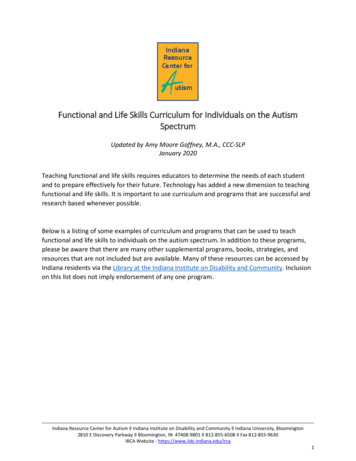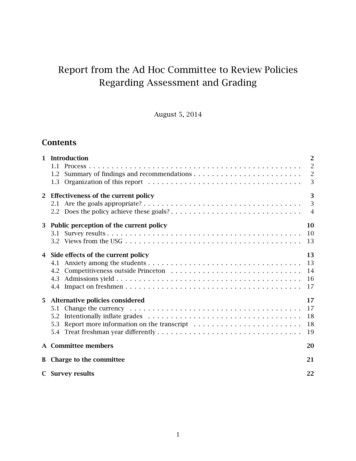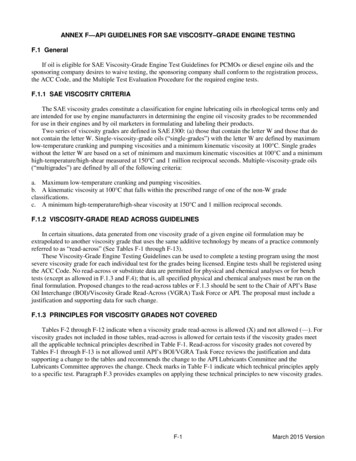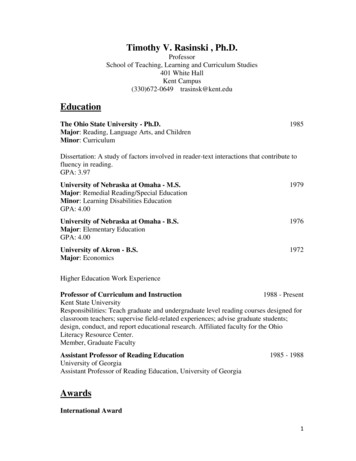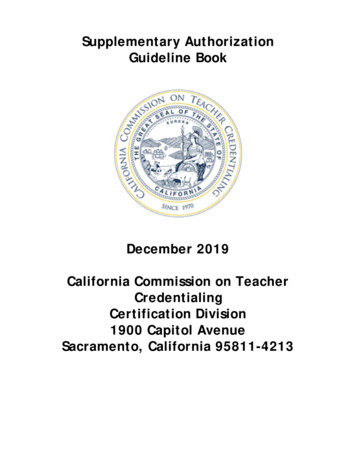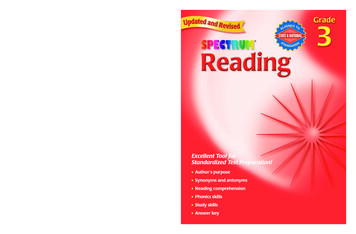
Transcription
Grades 9 to 12Design DraftingManitoba Technical-VocationalCurriculum Frameworkof Outcomes
Gr ades 9 to 12Design DraftingManitoba Technical-Vocational CurriculumFramework of Outcomes2017M a ni t o b a E d u c a t i o n a n d Tr ainin g
Manitoba Education and Training Cataloguing in Publication DataGrades 9 to 12 design drafting : Manitoba technical-vocationalcurriculum framework of outcomesIncludes bibliographical referencesISBN: 978-0-7711-8039-2 (pdf)1. Drafters—Vocational guidance.2. Architectural drawing—Study and teaching (Secondary)—Manitoba.3. Engineering design—Study and teaching (Secondary)—Manitoba.4. Mechanical drawing—Study and teaching (Secondary)—Manitoba.5. Technical education—Manitoba—Curricula.6. Vocational education—Manitoba—Curricula.I. Manitoba. Manitoba Education and Training.604.20712Copyright 2017, the Government of Manitoba, represented by the Minister ofEducation and Training.Manitoba Education and TrainingWinnipeg, Manitoba, CanadaEvery effort has been made to acknowledge original sources and to complywith copyright law. If cases are identified where this has not been done, pleasenotify Manitoba Education and Training. Errors or omissions will be correctedin a future edition. Sincere thanks to the authors and publishers who allowedtheir original material to be used.Any websites referenced in this resource are subject to change without notice.Educators are advised to preview and evaluate websites and online resourcesbefore recommending them for student use.This resource is available on the Manitoba Education and Training websiteat www.edu.gov.mb.ca/k12/cur/teched/sy tech program.html.Available in alternate formats upon request.
ContentsAcknowledgementsvTechnical-Vocational Education Overview1Design Drafting Overview2Design Drafting as a TVE Cluster22017 Revisions to the Design Drafting Curriculum3Career and Employment Opportunities4Implementation of Design Drafting4Strands in the Design Drafting Curriculum5Qualifications of Design Drafting Teachers5Comparison of TVE Design Drafting withIndustrial Arts Drafting Design Technology6Comparison of TVE Design Drafting withIndustrial Arts Drafting Design Technology7Frequently Asked Questions7TVE Design Drafting7Industrial Arts Drafting Design7Design Drafting Goals and General Learning Outcomes8Specific Learning Outcomes (SLOs)9Course Descriptions98434 Introduction to Design Drafting108435 Design Drafting Essentials 1118436 Design Drafting Essentials 2118437 Architectural Design Drafting118438 Engineering Design Drafting128439 Advanced Engineering Design Drafting128648 Advanced Architectural Design Drafting138649 Applied Architectural Design Drafting138669 Applied Engineering Design Drafting13Design Drafting Competitions14Guide to Reading Design Drafting Goals andLearning Outcomes15Grades 9 to 12 Design Drafting: Introductory Coursesand Architectural Stream General and Specific LearningOutcomes by Goal17Goal 1: Solve problems using the design process.19Goal 2: Communicate design solutions.26Goal 3: Use appropriate materials and processesof building/manufacturing.34Goal 4: Present design solutions.36Goal 5: Describe and apply the common toolsand equipment used in design drafting.40Goal 6: Describe and apply transferable cross-curricularknowledge and skills that relate to design drafting.45Goal 7: Demonstrate an awareness of sustainabilityas it pertains to design drafting.51Goal 8: Understand the evolution of design drafting,including its technological progression andemerging trends.55Goal 9: Follow the ethical and legal standards indesign drafting.56Contentsiii
Goal 10: Demonstrate a knowledge of and ability torecognize and apply appropriate health and safetyrequirements and practices to maintain asafe workplace.58Goal 11: Demonstrate employability skills requiredin design drafting.60Goal 12: Describe career opportunities indesign drafting.64Goal 1: Solve problems using the design process.69Goal 2: Communicate design solutions.75Goal 3: Use appropriate materials and processes ofbuilding/manufacturing.84Goal 4: Present design solutions.86Goal 5: Describe and apply the common toolsand equipment used in design drafting.91Goal 6: Describe and apply transferable cross-curricularknowledge and skills that relate to design drafting.97Goal 7: Demonstrate an awareness of sustainabilityas it pertains to design drafting.103Goal 8: Understand the evolution of design drafting,including its technological progression andemerging trends.106Goal 9: Follow the ethical and legal standards indesign drafting.107Goal 10: Demonstrate a knowledge of and ability torecognize and apply appropriate health and safetyrequirements and practices to maintain asafe workplace.109Grades 9 to 12 Design Drafting111Goal 12: Describe career opportunities indesign drafting.115BibliographyGrades 9 to 12 Design Drafting: Introductory Courses andEngineering Stream General and Specific LearningOutcomes by Goal67ivGoal 11: Demonstrate employability skillsrequired in design drafting.117
AcknowledgementsManitoba Education and Training gratefully acknowledges the contributions of the following individuals in the development ofGrades 9 to 12 Design Drafting: Manitoba Technical-Vocational Curriculum Framework of Outcomes.Members of the 2017Revision TeamMembers of the 2010–2011Development TeamMembers of PreviousDevelopment TeamsTara Hamilton DuffieldCrocus Plains Regional Secondary SchoolBrandon School DivisionGordon MacRaeTechnical-Vocational High SchoolWinnipeg School DivisionMiro GawinskiCrocus Plains Regional Secondary SchoolBrandon School DivisionGordon MacRaeTechnical-Vocational High SchoolWinnipeg School DivisionMiro GawinskiCrocus Plains Regional Secondary SchoolBrandon School DivisionOtto GebhardtRed River CollegeCrystal LachanceSisler High SchoolWinnipeg School DivisionGordon MacRaeTechnical-Vocational High SchoolWinnipeg School DivisionRichard MaslankaRoseau Valley SchoolBorder Land School DivisionRon McCutcheonSteinbach Regional Secondary SchoolHanover School DivisionMichael St. LawrenceKildonan-East CollegiateRiver East-Transcona School DivisionRon SugdenEdward Schreyer SchoolSunrise School DivisionAcknowledgementsv
Industry Representatives(provided a written ranking ofessential skills and/or attendedan advisory meeting)Manitoba Educationand Training StaffviGreg SchipperLoewenJessica Cram#10 Architectural GroupDarrell TrudeauNew Flyer IndustriesReg SpurrillLM ArchitectsKim MoggWinnipeg Airport AuthorityEugene ManchurBoeing CanadaChris LaingUniversity of Manitoba, EngineeringLori AmedickUniversity of Manitoba, ArchitectureMike HewkoMCM ArchitectsStuart KiddWesteel IndustriesLouise BoissonneaultCoordinatorDocument Production Services UnitEducational Resources BranchJohn FinchCoordinatorLearning Support and Technology UnitInstruction, Curriculum and Assessment BranchKristin GrapentineDesktop PublisherDocument Production Services UnitEducational Resources BranchGilles LandryConsultantLearning Support and Technology UnitInstruction, Curriculum and Assessment BranchKim PoirierConsultantLearning Support and Technology UnitInstruction, Curriculum and Assessment BranchMarjorie PoorPublications EditorDocument Production Services UnitEducational Resources BranchGrades 9 to 12 Design Drafting
Te c h n i c a l- V o c a t i o n a lEduc at ion Overv iewIn 2013, Manitoba Education released the documentTechnical-Vocational Education Overview, available at www.edu.gov.mb.ca/k12/cur/teched/sy tech program.html, toprovide the philosophical and pedagogical underpinningsfor curriculum development and the teaching of courses inthe Senior Years Technology Education Program.This overview presents educators with the vision and goalsof technical-vocational education (TVE) in Manitoba. Topicsinclude the following:QQcurriculum revitalization and renewalQQcurriculum framework and implementationQQarticulation of programmingQQassessment and reportingQQsafetyQQemployability/essential skills and career developmentQQsustainable developmentTVE clusters of courses are designed to encourage studentsto explore career options in designated trades and trainedoccupations and to address labour shortages in theseareas. The TVE curriculum includes course clusters forboth designated trades (trades designated for apprenticeshiptraining and certification by Apprenticeship Manitoba) andtrained occupations (not designated as trades).The TVE curriculum is significantly different from othersubject areas, such as industrial arts. It has distinctivequalities which, when respected, will provide students witha uniquely valuable experience that they cannot receive fromany other curriculum.TVE gives students the opportunity to learn, from anindustry-certified teacher with industry experience, thetheoretical and practical aspects of one specific trade ortrained occupation in order to facilitate their transitionfrom school to work or to post-secondary education inthat trade or trained occupation, or into an associatedtrade or occupation. This transition is accomplished byhaving students complete an entire TVE cluster of coursesin a setting that, as much as possible, emulates an actualworkplace.In the TVE curriculum, the emphasis is on hands-on learningactivities. For instructional purposes, the sequence oflearning outcomes and the learning outcomes included ineach unit of study can vary based on the projects within thecourses.Cross-curricular learning outcomes, which include thosein mathematics, science, and the interpretation of technicaldocuments, are to be integrated into the authentic learningactivities of the courses.The TVE curriculum includes Grades 9 to 12 courses in avariety of areas, including design drafting.Overview1
Design Drafting OverviewGrades 9 to 12 Design Drafting: Manitoba Technical-VocationalCurriculum Framework of Outcomes identifies the goals,general learning outcomes (GLOs), and specific learningoutcomes (SLOs) for nine design drafting courses. Thisframework is intended for use in all Manitoba schoolsteaching design drafting courses as part of the Senior YearsTechnology Education Program.Design Drafting as a TVE ClusterGrades 9 to 12 Design Drafting: Manitoba Technical-VocationalFramework of Outcomes has been developed as a technicalvocational education (TVE) cluster of courses.This curriculum prepares students for various careersassociated with design drafting. Like all other TVE courses,design drafting courses should be taught only as partof a complete cluster, approved by Manitoba Educationand Training.This cluster of courses is designed to not only teach studentshow to use CADD software as an important tool withindrafting, but to also understand the theory and functionsupporting designs that stem from architectural, mechanical,and civil backgrounds.These design drafting courses prepare students for entrylevel employment in architecture, mechanical engineering,civil engineering, and manufacturing companies, or forfurther education at college or university in draftingtechnology, architecture, interior design, landscape2Grades 9 to 12 Design Draftingarchitecture, urban design, or mechanical, civil, aerospace,chemical, biological, environmental, or electrical engineering.Students completing the design drafting courses will beable toQQQQvisualize the relationship between drawings and theobjects they representvisualize the relationship between componentsand assembliesQQdevelop and prepare design sketchesQQdesign to specifications and standardsQQdevelop and prepare designs and technical drawingsQQoperate computer-assisted design and drafting(CADD) workstationsQQwrite technical reportsQQcommunicate aestheticallyQQincorporate sustainable practicesQQprepare construction specifications, costs, andmaterial estimatesQQapply mathematics and physicsQQdemonstrate an understanding of material propertiesQQdemonstrate an understanding of manufacturingprocesses and construction methodsQQsolve problemsQQwork independentlyQQQQcommunicate and work with peers, clients, andindustry professionalswork to meet deadlines
Design drafting consists of two distinct disciplines.QQArchitectural Design DraftingArchitectural design drafting focuses on residentialarchitecture, which deals with the design of houses,cottages, small structures, and light commercialbuildings. Residential architecture involves the designof structural, electrical, heating, cooling, and plumbingsystems. Students will be introduced to civil engineeringconcepts, which deal with the design and constructionof residential subdivisions and associated civilengineering infrastructure. Consideration must be givento construction specifications, building codes, materialselection, and costs.QQ2017 Revisions to the Design Drafting CurriculumDuring the 2016/2017 school year, a committee of designdrafting teachers was struck to make revisions to the highschool curriculum. The revisions were not extensive, and thecourse codes and names remain the same. Revisions includedthe following:QQEngineering Design DraftingEngineering design drafting focuses on mechanicalengineering, which deals with the broad areas ofheat, energy, force, and motion, and their effects on amultitude of products. Mechanical engineers may beinvolved in the design of large industrial machinery,power plants, automobiles and aircraft, robots,biomedical devices and equipment, manufacturingprocesses, precision measurement and data acquisitionequipment, and new materials, among others.QQDesign Drafting Essentials I 20S/20E/20M andDesign Drafting Essentials II 30S/30E/30M have beenredesigned as a pair of courses to teach students theessential knowledge and skills in architectural andmechanical drafting. Teachers have the flexibility tofocus on one or both of these topics in each course.However, by the end of both courses, students needto have had significant exposure to both architecturaland mechanical drafting in order to be prepared tosuccessfully complete the remaining courses in thiscluster.Applied Architectural Design Drafting 40S/40E/40Mhas been revised to give teachers more flexibility tofocus on applied architectural and/or applied civilengineering projects.Overview3
Career and Employment OpportunitiesStudents who have completed the design drafting coursescan seek entry-level employment as draftspersons inarchitectural, mechanical, or civil engineering, andmanufacturing companies, or adapt their learning toother occupational streams. Draftspersons preparedesigns, drawings, and related technical information inmultidisciplinary teams or in support of engineers, architects,or industrial designers, or they may work independently.They are employed by architectural and engineering firms;consulting and construction companies; utility, resource,and manufacturing companies; all levels of government;and by a wide range of other organizations. Graduates canalso seek employment in construction, manufacturing, andother industries.Industry typically requires employees entering the designdrafting fields to have post-secondary education. Thedesign drafting courses provide a foundation for studentsto continue to build on in post-secondary education inarchitecture, engineering, interior design, urban design,landscape architecture, drafting technologies, and relatedfields. To facilitate the seamless transition from high schooldesign drafting to a related college or university program,students will receive advanced credit with articulatedpost-secondary institutions, such as Red River College andAssiniboine Community College.To prepare our students to enter industry or post-secondaryprograms, courses taught in design drafting will incorporatethe latest computer-assisted design and drafting (CADD)technology and equipment.4Grades 9 to 12 Design DraftingFor additional information and resources about designdrafting occupations, see the following:QQQQNational Occupational ssential Skills plementation of Design DraftingTo receive a Senior Years Technology Education diploma, astudent must complete the minimum of eight departmentallydeveloped credits from an approved TVE cluster, togetherwith 16 compulsory credits and six optional credits.The grade level in which the design drafting coursesare offered is a local school-based decision. It is highlyrecommended that the sequencing of credits follow thesequence set out in this document.Students entering design drafting will begin with thefoundation courses and continue to explore design-relatedcareers through the architectural and engineering streams.Projects may continue from one course to another.
Strands in the Design Drafting CurriculumThe general and specific learning outcomes for each coursebelong to three distinct but related strands. As studentsmove from Grades 9 to 12, the expectations within eachstrand will increase in complexity and depth and will movethe students from sampling to transition to work or postsecondary education.Technology Fundamentals [Theory](Foundational Knowledge, Technological Literacy, Numeracy and Literacy,Sustainable Development, New and Emerging Technology)Technology Skills [Practical](Processes based on the fundamentals, tools and equipment, ICT)Professional Practice: Students develop the knowledge,skills, and attitudes required to make a transition topost-secondary education or the workplace. Studentswill demonstrate an understanding of health andsafety standards and issues. Students will develop theemployability skills to successfully continue in the industryand explore career opportunities and the education andtraining required in the field of study. These are designatedby the letter P.Qualifications of Design Drafting TeachersOnly vocationally certified teachers should teach TVEcourses, including the ones in this design drafting cluster.Vocational certification includes three components:QQProfessional Practice(Health and Safety, Employability Skills, Career Development)Technology Fundamentals [Theory]: Students developfoundational knowledge related to design drafting. Studentswill make connections to cross-curricular areas that includenumeracy and literacy, sustainable development, andscientific literacy as it relates to the subject area. These aredesignated by the letter F.Technology Skills [Practical]: Students develop thetechnological skills necessary to enter the industry. These aredesignated by the letter S.QQQQPost-Secondary Certification in a Drafting-RelatedProfession: Design drafting teachers need to have formalpost-secondary education in a program that includesdrafting. Candidates may be graduates of professionalengineering, architectural, or certified engineeringtechnology programs.Industry Experience: Design drafting teachers need tohave been employed, for at least six years, in a professionthat includes drafting. This will enable them to sharetheir industry experience with students.Technical Vocational Teaching Certificate: TVE teachersshould have a technical vocational teaching certificate,obtained by completing Red River College’s one-yearTechnical Vocational Teacher Education diplomaOverview5
program. For information about this program, see rrc.mb.ca/Catalogue/ProgramInfo.aspx?ProgCode TECVFDP&RegionCode WPGEmploying only vocationally certified teachers to teachTVE courses preserves the integrity of TVE programmingby ensuring that teachers are able to share their first-handexperience working in design drafting. Students receiveinstruction from somebody who has been involved inthat profession.For further information, see “Professional Certification:Technical Vocational Teacher” on the Manitoba Educationand Training website at onal.html.Comparison of TVE Design Drafting with IndustrialArts Drafting Design TechnologyLike all TVE curricula, Grades 9 to 12 Design Drafting:Manitoba Technical-Vocational Framework of Outcomes has beendeveloped to prepare high school students for a career. Inthe case of design drafting, students learn the knowledge,skills, and attitudes required to work in a career with designdrafting as a major component. This includes such careersas professional engineer, architect, or certified engineeringtechnologist. This curriculum has not been developed asa general interest cluster of courses in drafting. Schoolsinterested in teaching such a cluster are invited to teachthe Industrial Arts curricula, which can be found on thedepartment’s website at www.edu.gov. mb.ca/k12/cur/teched/ind arts.html.6Grades 9 to 12 Design DraftingAlthough the design drafting and industrial arts draftingdesign technology curricula share some common content,they have been developed for completely different purposes,and have significant differences in content. The chart on thefollowing page summarizes some of the differences betweendesign drafting (as a TVE cluster of courses) and draftingdesign technology (as an industrial arts cluster of courses).
Comparison of TVE Design Drafting with Industrial Arts Drafting Design TechnologyFrequently Asked QuestionsTVE DesignDraftingIndustrial ArtsDrafting DesignTechnology1.Is the purpose of the curriculum to facilitate students’ transition to a career withdesign drafting as a major component?YesNo2.Does the instruction try to emulate, as far as possible, a design drafting workplace?YesNo3.Does the curriculum mandate employability skills such as punctuality and timemanagement?YesNo4.Is the teacher required to have post-secondary education in a drafting-related fieldsuch as professional engineering, architectural, or engineering technology?YesNo5.Is the teacher required to have experience working in a drafting-related field?YesNo6.Does the cluster prepare students for working in a drafting-related occupation?YesNo7.Does the cluster focus on preparing students for entry-level employment in adrafting-related field after high school?YesNo8.Is the teacher required to have a Manitoba general teacher certificate?NoYes9.Is the teacher required to have a Manitoba technical vocational teaching certificate?YesNoYesNoYesNoYesNoNoYes10. Do schools require special permission from Manitoba Education and Training to offera cluster of courses?11. Do schools have to offer all of the courses in the cluster?12. Do the clusters focus on only one occupation?13. Can schools offer hybrid clusters, made up of courses from several clusters?Overview7
Design Drafting Goals and General LearningOutcomesCurriculum goals outline the major curriculum componentsin addition to the general or across-the-curriculum learninggoals for the subject area. The overall goals for designdrafting are based on three broad components:QQQQQQprocess for design draftingcross-curricular knowledge and skills, sustainability, andemerging trendsethical and legal standards, health and safety practices,employability skills, and career developmentThe design drafting curriculum includes 12 course goals,which are broken down into general learning outcomes(GLOs), which are broken down into specific learningoutcomes (SLOs).Please note that some design drafting courses do not addressall of these GLOs.GLO 2.2:Goal 3:Solve problems using the design process.GLO 1.1:Define design problems.GLO 1.2: Research and analyze information for designsolutions.GLO 1.3: Synthesize information and ideas to create designsolutions.Goal 2:Communicate design solutions.GLO 2.1:8Prepare computer models of design solutions.Grades 9 to 12 Design DraftingUse appropriate materials and processes ofbuilding/manufacturing.GLO 3.1:Describe materials used in design solutions.GLO 3.2: Describe building/manufacturing processes used indesign solutions.Goal 4:Present design solutions.GLO 4.1:Plan and organize presentations of design solutions.GLO 4.2: Use presentation production methods.GLO 4.3: Present/defend design solutions.Goal 5:Describe and apply the common tools andequipment used in design drafting.GLO 5.1:Describe and use drawing and modelling tools andequipment.GLO 5.2: Describe and use computer hardware andequipment.GLO 5.3: Describe and use software.Cross-curricular, Sustainability,and Emerging TrendsProcess for Design DraftingGoal 1:Prepare working and presentation drawings anddocuments.Goal 6:Describe and apply the transferable cross-curricularknowledge and skills that relate to design drafting.GLO 6.1:Describe and apply mathematical concepts as theyrelate to design drafting.GLO 6.2: Read, interpret, and communicate information.GLO 6.3: Understand scientific concepts as they apply todesign drafting.Goal 7:Demonstrate an awareness of sustainability as itpertains to design drafting.
GLO 7.1:Understand the impact of architectural/engineeringdesign on the environment.GLO 7.2:Describe the impact of architectural/engineeringdesign on human health and well-being.GLO 7.3:Recognize the economic impact of sustainablepractices in architectural/engineering design.Goal 8:Understand the evolution of design drafting, includingits technological progression and emergingtrends.GLO 8.1:Describe the evolution of design drafting, includingits technological progression and emerging trends.Safety and Health, Employability Skills,and Career DevelopmentGoal 9:Follow the ethical and legal standards in drafting.GLO 9.1:Incorporate the local and national building codesand standards as well as manufacturing andengineering standards into designs.GLO 9.2:Describe the ethical expectations of designers.Goal 10: Demonstrate a knowledge of and ability torecognize and apply appropriate health and safetyrequirements and practices to maintain a safeworkplace.GLO 10.1: Demonstrate an awareness of rights,responsibilities, and safety procedures for specifictools, equipment, and working environments.GLO 10.2: Describe health and safety laws and regulations.Goal 11: Demonstrate employability skills required in designdrafting.GLO 11.1: Demonstrate fundamental employability skills.GLO 11.2: Demonstrate personal management skills.GLO 11.3: Demonstrate teamwork skills.Goal 12: Describe career opportunities in design drafting.GLO 12.1: Describe post-secondary opportunities related todesign drafting.GLO 12.2: Describe career opportunities available in designdrafting across industries.Specific Learning Outcomes (SLOs)Grades 9 to 12 Design Drafting: Manitoba Technical-VocationalCurriculum Framework of Outcomes identifies specific learningoutcomes (SLOs) for use in all Manitoba schools teaching theGrades 9 to 12 design drafting courses as part of the SeniorYears Technology Education Program. Specific learningoutcome statements define what students are expected toachieve by the end of the course.It is essential that students learn safety practices andemployability skills; therefore, with a few exceptions,all SLOs related to safety and to employability skills arerepeated from course to course.Please note that SLOs are not identified for the goals andGLOs that are not addressed in a given course.Course DescriptionsCourse titles, descriptions, and codes for the nine designdrafting courses follow. For an explanation of the codes, referto the Subject Table Handbook: Technology Education: StudentRecords System and Professional School Personnel System,available at www.edu.gov.mb.ca/k12/cur/teched/sth teched.html (Manitoba Education and Training).Overview9
8434 Introduction to Design Drafting15S/15E/15M10S/10E/10MIntroduction to Design Drafting is intended for studentswishing to sample architectural/engineering/interiordesign drafting.Curriculum content focuses on an exploration of designdrafting. The emphasis will be on exploring artistic andtechnical computer drawings using project-based activities.Students will present their design solutions to others.Topics include introductions to the following:QQfreehand sketchingQQprinciples of designQQdrafting standardsQQmaterials and processesQQcomputer modellingQQarchitectural/engineering basicsRevisions to Design Drafting Essentials 1 & DesignDrafting Essentials 2Design Drafting Essentials 1 20S/20E/20M and DesignDrafting Essentials 2 30S/30E/30M have been redesigned asa pair of courses to teach students the essential knowledgeand skills in architectural and mechanical drafting. Teachershave the flexibility to focus on one or both of these topics ineach course. However, by the end of both courses, studentsneed to have had significant exposure to both architecturaland mechanical drafting in order to be prepared tosuccessfully complete the remaining courses in this cluster.In other words, teachers have the option to do any one of thefollowing:QQQQThe course includes an exploration of safety, employabilityskills, career development, sustainability, and new andemerging technologies in design drafting.QQ10Grades 9 to 12 Design DraftingTeach only architectural drafting in Design DraftingEssentials 1, and only mechanical drafting in DesignDrafting Essentials 2, ensuring that students have equalexposure to each one.Teach only mechanical drafting in Design DraftingEssentials 1, and only architectural drafting in DesignDrafting Essentials 2, ensuring that students have equalexposure to each one.Teach both architectural and mechanical drafting in bothcourses, ensuring that students have equal exposure toeach one.
8435 Design Drafting Essentials 120S/20E/20MTopics include the following:Design Drafting Essentials 1 is intended for students wishingto explore architectural/mechanical design drafting.QQfreehand sketchingQQprinciples of designCurriculum content focuses on an introduction toarchitectural/mechanical design drafting. The emphasis willbe on project-based learning activities. Students will presenttheir design solutions to others.QQdrafting standardsQQmaterials and processesQQcomputer modellingQQarchitectural/mechanical conceptsQQarchitectural plan and elevation drawingQQmechanical multi-view drawingsTopics include the following:QQfreehand sketchingQQprinciples of designQQdrafting standardsQQmaterials a
Design drafting consists of two distinct disciplines. QQ Architectural Design Drafting Q Architectural design drafting focuses on residential architecture, which deals with the design of houses, cottages, small structures, and light commercia
